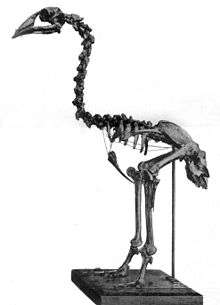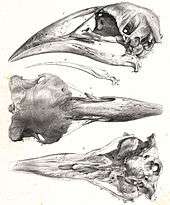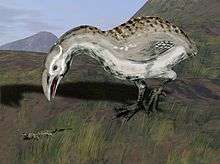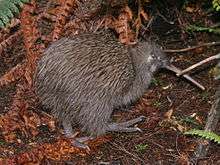Adzebill
| Adzebills | |
|---|---|
 | |
| Skeleton of A. otidiformis, Canterbury Museum | |
| Scientific classification | |
| Kingdom: | Animalia |
| Phylum: | Chordata |
| Class: | Aves |
| Order: | Gruiformes |
| Family: | †Aptornithidae Mantell, 1848 |
| Genus: | †Aptornis Owen, 1844 |
| Species | |
| |
| Synonyms | |
| |
_601651_(cropped).jpg)
The adzebills, genus Aptornis, were two closely related bird species, the North Island adzebill, Aptornis otidiformis, and the South Island adzebill, Aptornis defossor, of the extinct family Aptornithidae. The family was endemic to New Zealand. A fossil species, Aptornis proasciarostratus, is known from the Miocene Saint Bathans Fauna.[1]
Taxonomy

They have been placed in the Gruiformes but this is not entirely certain. It was also proposed to ally them with the Galloanserae (Weber & Hesse, 1995). Studies of morphology and DNA sequences place them variously close to and far off from the kagu of New Caledonia, as well as the trumpeters; however, on first discovery of fossils, they were mistaken for ratites, specifically small moa. Its morphological closeness to the kagu may be the result of convergent evolution, although New Zealand's proximity to New Caledonia and shared biological affinities (the two islands are part of the same microcontinent) has led some researchers to suggest they share a common ancestor from Gondwana. The Gondwanan sunbittern is the closest living relative of the kagu, but these do not seem to be close to the Gruiformes proper (i.e. cranes, rails and allies. See e.g. Fain & Houde, 2004[2]). On the other hand, should the adzebills be closer to the trumpeters, placement in the Gruiformes is likely to be correct even if the kagu and sunbittern are split off.
A 2011 genetic study found A. defossor to be a Gruiform. There are no available DNA sequences for A. otidiformis, but it was assumed the two species were more closely related to each other than to other birds.[3]
Description
In life the adzebills were massive gruiforms, about 80 cm in length with a weight of 18 kg, making them about the size of small moa (with which they were initially confused on their discovery) with enormous downward-curving and pointed bill, and strong legs.[4] They were flightless and had extremely reduced wings, smaller than those of the dodo compared to the birds' overall size, and with a uniquely reduced carpometacarpus (Livezey, 1994).
The two species varied mostly in size with the North Island adzebill being the smaller species; their coloration in life is not known however.
Habitat and behaviour

Their fossils have been found in the drier areas of New Zealand, and only in the lowlands. Richard Owen, who described the two species, speculated that it was an omnivore, and analysis of its bones by stable isotope analysis supports this. Levels of enrichment in 13C and 15N for two specimens of Aptornis otidiformis compared with values for a moa, Finsch's duck and insectivores like the owlet-nightjars suggested that the adzebill ate species higher in the food chain than insectivores.[5] They are thought to have fed on large invertebrates, lizards, tuataras and even small birds.
Extinction
The adzebills were never as widespread as the moa, but subjected to the same hunting pressure as these and other large birds by the settling Polynesians (and predation of eggs/hatchlings by accompanying kiore and dogs). They became extinct before the arrival of European explorers.
References
- Fain, Matthew G. & Houde, Peter (2004): Parallel radiations in the primary clades of birds. Evolution 58(11): 2558-2573. doi:10.1554/04-235 PMID 15612298 PDF fulltext
- Livezey, Bradley C. (1994): The carpometacarpus of Apterornis. Notornis 41(1): 51–60. PDF fulltext
- Weber, Erich & Hesse, Angelika (1995): The systematic position of Aptornis, a flightless bird from New Zealand. Courier Forschungsinstitut Senckenberg 181: 292-301.
- Worthy, Trevor H. (1989): The glossohyal and thyroid bone of Aptornis otidiformes. Notornis 36(3): 248 PDF fulltext
- Worthy, Trevor H., & Holdaway, Richard N. (2002) The Lost World of the Moa, Indiana University Press:Bloomington, ISBN 0-253-34034-9
- North Island Adzebill. Aptornis otidiformis. by Paul Martinson. Artwork produced for the book Extinct Birds of New Zealand, by Alan Tennyson, Te Papa Press, Wellington, 2006
- South Island Adzebill. Aptornis defossor. by Paul Martinson. Artwork produced for the book Extinct Birds of New Zealand, by Alan Tennyson, Te Papa Press, Wellington, 2006
Footnotes
- ↑ Worthy, T.H.; Tennyson, A.J.D.; Scofield, R.P. 2011: Fossils reveal an early Miocene presence of the aberrant gruiform Aves: Aptornithidae in New Zealand. Journal of ornithology, 152(3): 669-680. doi: 10.1007/s10336-011-0649-6 ZooBank
- ↑ Note that their proposed "Metaves" are only weakly supported, and contain several nigh-impossible grouping. A fairly close kagu-sunbittern relationship, on the other hand, is almost certain by now.
- ↑ Lanfear, R.; Bromham, L. (2011). "Estimating phylogenies for species assemblages: A complete phylogeny for the past and present native birds of New Zealand". Molecular Phylogenetics and Evolution. 61 (3): 958–963. doi:10.1016/j.ympev.2011.07.018. PMID 21835254.
- ↑ http://nzbirdsonline.org.nz/species/south-island-adzebill
- ↑ Worthy, T. H., Richard N. Holdaway (2002):p. 212
| Wikispecies has information related to Aptornis |
